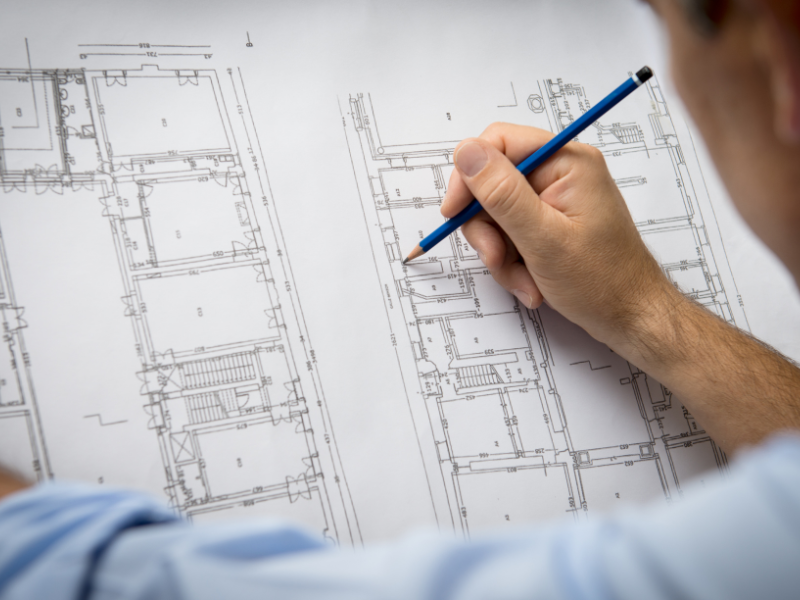Architect Portfolio Examples That Attract Clients Immediately
Architect Portfolio Examples That Attract Clients Immediately
Blog Article
Comprehending the Diverse Career Paths Available for Aspiring Architect
As a hopeful Architect, you have a world of career courses waiting on you. Each course provides one-of-a-kind obstacles and chances to apply your imagination and technological know-how. Whether you're drawn to typical architecture or the subtleties of lasting design, there's a specific niche that aligns with your rate of interests. Recognizing these varied options can form your expert trip, however which direction will you pick to explore initially?
Typical Architecture: Designing Structures and buildings
Traditional architecture focuses on developing structures and frameworks that mix capability with visual charm. Your designs can reflect cultural heritage, showcasing neighborhood practices while meeting contemporary needs.
You'll develop abilities in composing, model-making, and website analysis, enabling you to picture and interact your concepts efficiently. Engaging with customers, you'll require to comprehend their vision and equate it right into practical styles.
Additionally, building codes and sustainability practices are vital in your work, guaranteeing your frameworks are secure and eco-friendly. As you grow in your profession, you'll locate opportunities in residential, commercial, or also restoration projects, each offering distinct obstacles. Welcoming conventional design leads the method for a fulfilling profession that pays homage to the past while forming the future.
Urban Planning: Forming Neighborhoods and Public Spaces
As an aspiring Architect, you can play a necessary role as a city planner, changing exactly how communities work and interact. By employing area engagement methods, you'll guarantee that citizens have a voice fit their atmosphere. And also, integrating sustainable layout principles will certainly aid produce areas that not just satisfy today's demands but likewise secure the future.
Function of Urban Planners
While several may assume of architects as the single enthusiasts behind structures, city planners play a necessary duty fit the more comprehensive landscape of communities and public areas. They examine land use, zoning legislations, and area needs to produce sustainable settings that enhance quality of life. By teaming up with various stakeholders, you'll assist create parks, transport systems, and suburbs that promote social interaction and access. Urban organizers also concentrate on environmental considerations, guaranteeing that growths incorporate environment-friendly spaces and assistance biodiversity. Your know-how in spatial design and community characteristics permits you to envision future growth while protecting social heritage. In this vital duty, you'll directly affect exactly how people experience their surroundings, making every project an opportunity for positive change.
Neighborhood Engagement Strategies
Reliable community involvement strategies are crucial for city coordinators to ensure that the voices of locals are heard and valued in the preparation procedure. To cultivate significant discussion, you must prioritize open forums and workshops where area members can share their ideas and problems. Use surveys and social media sites to reach a more comprehensive audience, ensuring varied point of views are consisted of. Working together with neighborhood organizations can boost trust fund and help with much deeper connections. It's essential to provide clear details regarding suggested projects and decision-making processes, permitting locals to really feel educated and equipped. By proactively listening and integrating comments, you'll develop spaces that show the area's requirements, eventually leading to more effective and sustainable urban atmospheres. Welcome transparency and constant discussion for long-term impact.
Sustainable Style Concepts
When designing urban spaces, incorporating lasting layout concepts is essential for developing environments that thrive both ecologically and socially. Think about integrating eco-friendly spaces, like parks and gardens, to boost biodiversity and enhance air quality.
Designing with water conservation in mind is also crucial-- think of rainfall gardens and absorptive surface areas to manage stormwater. Involving community members throughout the preparation procedure guarantees that the spaces you produce satisfy their requirements and urge social interaction. By embracing these principles, you'll add to dynamic, sustainable city landscapes that benefit everyone.

Landscape Architecture: Producing Lasting Outside Atmospheres
As you discover landscape style, you'll uncover necessary design principles that produce practical and beautiful outside areas. Lasting methods play an important duty in making sure these environments grow while minimizing ecological effect. And also, you'll find a range of job chances that enable you to make a genuine difference in exactly how people communicate with nature.
Design Concepts in Landscape
Understanding layout principles in landscape architecture is vital for producing lasting outside settings that integrate with nature. You'll need to consider components like equilibrium, range, and proportion to ensure your styles really feel natural and inviting. Additionally, pay focus to seasonal changes, developing with materials that match the environments year-round.
Lasting Practices Introduction
Lasting methods in landscape architecture not only focus on appearances however additionally prioritize ecological wellness and resource preservation. You can design areas that promote soil health, such as making use of natural materials and exercising permaculture principles. Eventually, these methods guarantee your layouts profit both people and the atmosphere for years to come.
Occupation Opportunities Exploration
With a strong foundation in lasting techniques, landscape style provides a variety of career paths that permit you to make a significant impact on the setting. You might function as a landscape designer, producing cosmetically pleasing and practical Full Article outdoor areas, or focus on ecological restoration, helping to revitalize damaged environments. Urban planners commonly collaborate with landscape engineers to produce green areas in metropolitan settings, enhancing city livability. If you're enthusiastic regarding education and learning, consider becoming a landscape architecture teacher, inspiring future generations. Additionally, you could function with nonprofits concentrated on environmental sustainability or involve in research study to innovate new techniques. Each course not just forms attractive environments yet also cultivates a much healthier earth for future generations.
Sustainable Style: Concentrating on Eco-Friendly Practices
As you explore your job in design, welcoming environmentally friendly techniques can establish you apart in an affordable field. Sustainable style focuses on developing structures that lessen ecological impact while improving resident well-being. By integrating sustainable products, energy-efficient systems, and sustainable building techniques, you'll add to a greener future.
Begin by getting expertise of eco-friendly certifications like LEED or BREEAM, which can reinforce your qualifications. Think about how all-natural light, ventilation, and thermal performance can enhance design. Collaborate with designers and environmental experts to innovate options that decrease waste and preserve resources.
Do not fail to remember the importance of neighborhood participation-- interesting local stakeholders can influence designs that balance with the setting. As clients progressively prioritize sustainability, your competence in environmentally friendly methods will not only attract tasks yet likewise accomplish your passion for responsible architecture. Accept this critical aspect of the profession, and watch your job grow.
Historical Conservation: Shielding and Recovering Cultural Heritage
While you commence on your building trip, consider the important function of historic preservation in keeping our social heritage. This field concentrates on the defense and restoration of considerable structures, websites, and structures that tell the tales of our past. By engaging in historical conservation, you'll help safeguard the building legacy that forms community identification.
As a historical conservation Architect, you'll evaluate historic value and evaluate the problem of frameworks. You'll work closely with preservationists and chroniclers to ensure authentic repair techniques are utilized. This career course allows you to mix creative thinking with research study, enabling you to create solutions that respect initial materials and craftsmanship.
Your work not only contributes to sustainability by recycling existing buildings however additionally fosters a sense of satisfaction within neighborhoods. Welcoming this course will help you end up being a guardian of history, preserving the tales and looks that improve our lives.
Interior Architecture: Enhancing Indoor Spaces
Historical conservation and interior style both share a commitment to enhancing the developed setting, but they focus on different elements. While historic preservation emphasizes maintaining a structure's cultural and historic worth, indoor design zeroes in on optimizing indoor areas for functionality and visual appeals.
As an aspiring Architect, you'll find that indoor architecture permits you to mix creativity with technical abilities. You'll create spaces that not just look great however also promote convenience and efficiency. This area includes comprehending how light, color, and materials communicate within a space, affecting state of mind and usability.
You'll work with numerous projects, from household homes to industrial offices, making certain that each setting meets the requirements of its occupants. By prioritizing individual experience, you can change interiors into motivating and practical spaces, making a significant influence on just how people connect with their surroundings. Embrace the possibility to boost indoor atmospheres and form the method people live and work.
Industrial Layout: Combining Capability With Looks
Industrial style plays a necessary duty in developing products that Visit Your URL flawlessly mix looks with performance, guaranteeing that what you use everyday is not only aesthetically appealing yet additionally functional. As an ambitious Architect, you could immerse on your own in this area, concentrating on designing everything from furniture to customer electronics. Your work entails recognizing user needs, materials, and manufacturing procedures, enabling you to create cutting-edge solutions that improve daily experiences.
In commercial design, you'll frequently collaborate with makers, designers, and marketing professionals, making certain that your designs are not just attractive yet likewise possible. This job path offers a vibrant setting where creativity meets usefulness, making it a rewarding option for designers interested in shaping the items of tomorrow.
Regularly Asked Concerns
What Educational Qualifications Do I Need to End Up Being an Architect?
To come to be an architect, you'll need a professional level in design, usually a Bachelor's or Master's. In addition, you'll have to complete a teaching fellowship and pass the Architect Registration Examination to exercise legally.
Exist Certification Requirements for Various Building Occupation Paths?
Yes, there're accreditation needs for various architectural courses. Architect. You'll require click to pass tests, full internships, and occasionally go after specialized training, relying on your selected focus, like landscape architecture, city design, or historic preservation
What Software Application Skills Are Essential for Designers Today?

Just How Can I Gain Practical Experience While Studying Style?
You can gain practical experience by interning at building companies, joining design competitors, volunteering for community projects, or teaming up with schoolmates on real-world projects. These possibilities boost your skills and build important connections in the industry.
What Task Opportunities Exist Outdoors Traditional Style Firms?
You can check out numerous job opportunities outside typical style companies, like metropolitan preparation, interior decoration, landscape architecture, building and construction administration, genuine estate development, or perhaps roles in sustainability consulting. Each deals distinct challenges and benefits.
Whether you're drawn to typical style or the nuances of sustainable design, there's a particular niche that lines up with your passions.When developing urban spaces, including sustainable style concepts is important for developing atmospheres that prosper both environmentally and socially.As you discover landscape style, you'll discover vital design principles that produce gorgeous and useful outside areas.Understanding layout concepts in landscape design is vital for producing lasting outdoor atmospheres that balance with nature.In commercial style, you'll often work together with marketers, designers, and makers, ensuring that your layouts are not just lovely however also viable.
Report this page